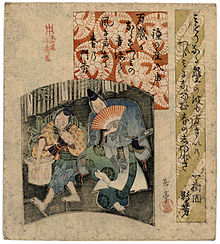- Manzai
-
Manzai (漫才) is a traditional style of stand-up comedy in Japanese culture, which usually involves two performers (manzaishi) —a straight man (tsukkomi) and a funny man (boke)—trading jokes at great speed. Most of the jokes revolve around mutual misunderstandings, double-talk, puns and other verbal gags.
In recent times, manzai has often been associated with the Osaka region, and manzai comedians often speak in the Kansai dialect during their acts.
Yoshimoto Kogyo, a large entertainment conglomerate based in Osaka, introduced Osaka-style manzai to Tokyo audiences, and coined the term "漫才" (one of several ways of writing the word manzai in Japanese; see "etymology" below) in 1933.
Contents
History
Originally based around a festival to welcome the New Year, manzai traces its origins back to the Heian period. The two manzai performers came with messages from the gods and this was worked into a standup routine, with one performer showing some sort of opposition to the word of the other. This pattern still exists in the roles of the boke and the tsukkomi.
Continuing into the Edo period, the style focused increasingly on the humor aspects of stand-up, and various regions of Japan developed their own unique styles of manzai, such as Owari manzai (尾張万歳), Mikawa manzai (三河万歳), and Yamato manzai (大和万歳). With the arrival of the Meiji Period, Osaka manzai (大阪万才) began changes that would see it surpass in popularity the styles of the former period, although at the time rakugo was still considered the more popular form of entertainment.
The spread of manzai was largely put to a halt after the conclusion of World War II.
With the end of the Taishō period, Yoshimoto Kōgyō—which itself was founded at the beginning of the era, in 1912—introduced a new style of manzai lacking much of the celebration that had accompanied it in the past. This new style proved successful and spread all over Japan, including Tokyo. Riding on the waves of new communication technology, manzai quickly spread through the mediums of stage, radio, and eventually, television.[1][2][3]
Etymology
The kanji for manzai have been written in various ways throughout the ages. It was originally written as (萬歳, lit. ten thousand years or banzai, meaning something like "long life"), using the archaic form of the character 万 (to which it was soon changed). The arrival of Osaka manzai brought another character change, this time changing the latter character to a simpler 才, which carries the basic meaning of "talent".
Boke and tsukkomi
Similar in execution to the concepts of "funny man" and "straight man" in double act comedy (e.g. Abbott and Costello), these roles are a very important characteristic of manzai. Boke (ボケ) comes from the verb bokeru (惚ける or 呆ける) which carries the meaning of "senility" or "air headed-ness" and is reflected in the boke's tendency for misinterpretation and forgetfulness. The word tsukkomi (突っ込み) refers to the role the second comedian plays in "butting in" and correcting the boke's errors. In performances it is common for the tsukkomi to berate the boke and hit them on the head with a swift smack; one traditional manzai prop often used for this purpose is a pleated paper fan called a harisen (張り扇).[4] Another traditional manzai prop is a small drum, usually carried (and used) by the boke.
The tradition of tsukkomi and boke is often used in other Japanese comedy, although it may not be as obviously portrayed as it usually is in manzai.[citation needed]
See also
- Downtown (owarai)—the dominant manzai team during the 1980s and 1990s
- Xiangsheng - the Chinese analogue to manzai.
References
External links
- "Commodified Comedians and Mediatized Manzai: Osakan Comic Duos and Their Audience" by Xavier Benjamin Bensky. A study in the cultural effects of manzai.
Categories:- Osaka
- Comedy genres
- Performing arts in Japan
- Japanese comedy and humour
- Japanese comedy duos
Wikimedia Foundation. 2010.


